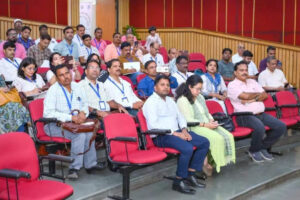
College Possible Uses AI Tool to Support Students, Coaches
As an advising specialist at College Possible, the largest college access organization in America, Becky Palmer typically works with about 450 college students each year, helping guide them through questions about financial aid, their eventual career goals and everything in between.
But when the Trump administration slashed funding for 32,000 AmeriCorps members in late April, it forced College Possible to lay off dozens of AmeriCorps volunteers who worked for the organization as coaches for high schoolers and college students from underserved backgrounds—and Palmer’s caseload nearly doubled to 886—“which is an insane amount to have for one person,” she said.
That number of advisees likely would have been unmanageable under regular circumstances. But over the previous year, College Possible had been developing an artificial intelligence tool that aimed to allow students to pose certain questions to a chat bot trained on the organization’s curriculum and data. Unlike large language models like ChatGPT, the College Possible bot only pulls from information the organization feeds it, rather than from the entire internet.
With the AI tool, Palmer said, “it really reduced the admin task time for such a large caseload.”
The resource is a result of a $1 million grant from Salesforce, an e-commerce software company based in Silicon Valley. When College Possible won the grant in 2023, staffers had no idea such massive cuts were coming to AmeriCorps. Instead, the plan was to leverage AI to give students more frequent access to information about college admissions and college success.
“The way we’re using the system is to make the coach more effective and the student [have] more agency in the kind of questions they want to ask and when they want to ask and if they want to speak to a coach,” said Siva Kumari, the organization’s CEO. “We have coaches in [high] schools; there was a certain time they were available [and] that was it. So now, it greatly expands the students’ access to information we already have. If we’re giving it to the coach, why not give it to the student as well?”
The innovation comes as higher education is grappling with how to incorporate new AI technologies into student services. Proponents of AI argue that the tools could become a massive asset for helping overworked staff members manage administrative tasks. But others fear that relying on generative AI may negatively impact the interpersonal relationships students have with their advisers or that a large language model—which can hallucinate, or make up answers—could offer students bad information.
Andrea Barrett, a professor of educational leadership at the University of Rochester who has been researching advising and admissions staff members’ opinions on using AI in their work, said that she has heard mixed reactions to the idea of using chat bots in her interviews.
The key question, she said, is “‘Can we use basic technology to still get students the basic information that they need … any time of day, and then keep the human-centered part of higher education’—which I think is really the cornerstone of higher education—‘and support students in a human-to-human capacity for the bigger questions, the tougher questions?’”
At the same time, she noted, not every college and university has the resources to develop their own tool to provide specialized and accurate information.
“If that’s not part of your institutional budget … it’s really about becoming more savvy with the systems that are already in place,” she said. “And so there might be limitations in what can be done.”
Building a Chat Bot
The team at Salesforce helped College Possible build the chat bot before launching it as a pilot to about half of their students. In order to develop the tool, said College Possible’s senior director of national program operations, Katie Cunningham, the nonprofit conducted surveys and focus groups to understand what students most frequently need help with.
“A lot of those things had to do with financial aid, FAFSA, scholarships—‘I have a gap, I have a bill, what do I do to pay?’” she said. Plus, those questions were often sent in a panic in the middle of the night when students notice an overdue balance, for example, making it particularly important to have a tool that could answer them immediately.
They also tried to understand students’ sentiments about AI. Most, it seemed, were very familiar with platforms like ChatGPT and eager to have a dedicated bot to answer all their college access questions. They still had some concerns, though, stressing that it was important to know when they were talking with the bot versus a real human.
So far, it’s been a success. But, Kumari stressed, the bot has not impeded the interpersonal relationships between students and their coaches. Rather, because students spend less time in meetings with their coaches asking rote questions, they now have more time available to develop a relationship with their coaches and spend more time talking about their hopes and fears about higher education.
“It’s just a really great support system for the advisers. It takes a lot of time off our hands with admin tasks and allows us to focus more on the one-on-one, individualized rapport building with students. That is so important for us,” Palmer said.
The bot also prompts students to connect with their coaches when it can’t answer a question on its own or when the student appears to be venturing into socio-emotional territory that might not be appropriate for a robot to handle.
Recovering From Cuts
Even though it was developed well before President Trump’s second term began, the tool ended up being a huge boon in the aftermath of the AmeriCorps cuts.
College Possible was forced to lay off all its advisers in Oregon, Washington and Wisconsin after its grants in those states were canceled. Like similar nonprofits, it pivoted as quickly as possible, reassigning the managers who had previously overseen AmeriCorps members to act as coaches themselves. It helped, Kumari noted, that she had heard rumors of impending cuts—portended by the Department of Government Efficiency’s visit to AmeriCorps’s headquarters earlier in April—and had developed a contingency plan in advance.
“Thanks to all the groundwork we did ahead of time in preparation for bad news, and obviously the commitment of the team to serve students, we were able to make the transition swiftly and rather smoothly and without interruption of service to the students,” she said.
Whereas each AmeriCorps coach had been embedded in a particular school, the managers moving into coaching roles took on workloads that included multiple schools.
The AI tool has lessened some of the burden of those former managers-turned-advisers, Kumari said.
“We had a volume of these AmeriCorps members—the [students-to-coach] ratios were quite small, because they were young people that had just come out of college,” she said. “Now we’re able to coach a lot more students with our full-time staff and this system.”
Source link



